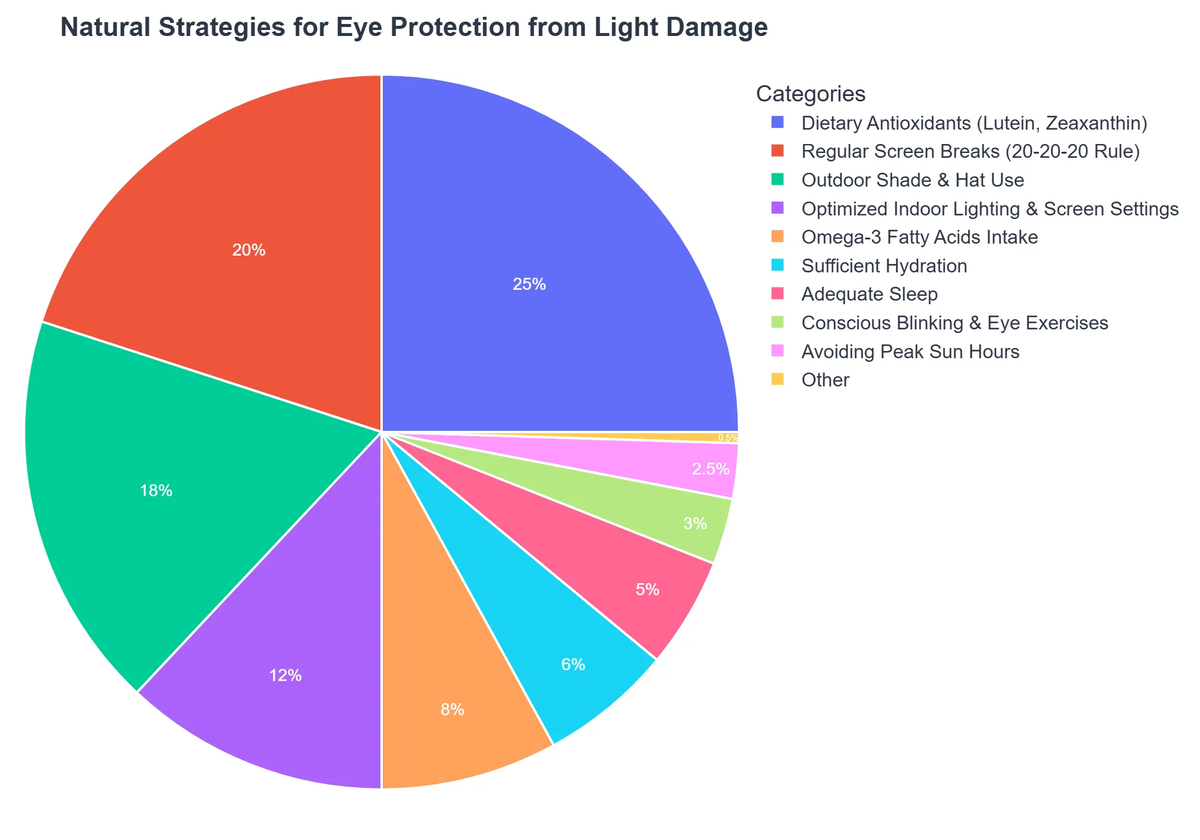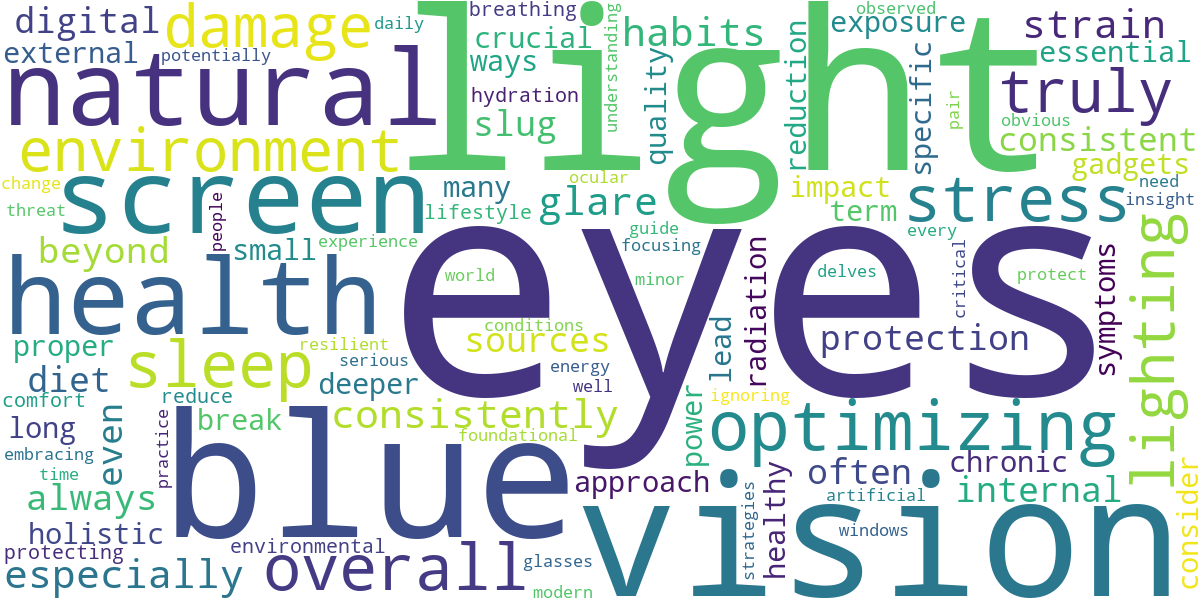Beyond Gadgets: Natural Ways to Protect Your Eyes from Light Damage
As a biohacker deeply invested in optimizing human performance, I’ve always understood that our eyes are not just windows to the soul, but critical gateways to our overall well-being. In our modern, screen-saturated world, concerns about light exposure are rampant. While blue light blocking glasses and specialized screens have their place, the real power lies in embracing natural eye protection strategies.
💡 Key Takeaways
- Dietary nutrients play a crucial role in internal eye defense against light.
- Strategic lighting and screen habits significantly reduce exposure.
- Outdoor time with natural light exposure benefits eye health.
- Simple lifestyle adjustments offer powerful, lasting eye protection.
“Our eyes are remarkably adaptable, but constant exposure to artificial light sources stresses them. Embracing natural protective measures isn’t just about avoiding damage; it’s about fostering ocular resilience from within.”
— Ekspertas, Specialistas
From my own experience, relying solely on external gadgets often misses the fundamental, holistic approach necessary for truly resilient vision. This guide delves into actionable, natural ways you can safeguard your precious eyesight from the daily onslaught of artificial and even natural light. We’ll explore how to nourish your eyes from within and optimize your environment.
In This Article
- →Beyond Gadgets: Natural Ways to Protect Your Eyes from Light Damage
- →Understanding the Enemy: Light Damage and Your Eyes
- →Nutritional Foundations for Resilient Vision
- →Environmental Hacking: Optimizing Your Surroundings
- →Lifestyle Habits for Long-Term Eye Health
- →Conclusion: A Holistic Approach to Vision
📊Quick Poll
Which natural method for eye protection do you find easiest to implement daily?
At a Glance
Understanding the Enemy: Light Damage and Your Eyes
Light, in its essence, is energy. While essential for life, certain spectrums and intensities can be detrimental to ocular health over time. The primary culprits we often discuss are high-energy visible (HEV) blue light and ultraviolet (UV) radiation.
The Insidious Impact of Blue Light: Blue light, emitted by digital screens, LED lighting, and even the sun, can penetrate deep into the eye, potentially reaching the retina. What I’ve consistently observed in my research is that prolonged exposure, especially without proper breaks, contributes significantly to digital eye strain, also known as computer vision syndrome. It can also disrupt melatonin production, affecting sleep cycles, which indirectly harms eye recovery. For a deeper dive, consider this external resource on what blue light is.
The Threat of UV Radiation: While blue light gets a lot of press, UV radiation from the sun remains a major threat. It’s directly linked to cataracts, macular degeneration, and other serious eye conditions. A non-obvious yet critical lesson I’ve learned is that UV damage is cumulative; every unprotected exposure adds to the long-term risk.
Recognizing the Symptoms of Eye Strain
Ignoring the warning signs can lead to more serious issues. A key insight from my clinical practice is that many people dismiss symptoms like:
- 👁️ Dry or irritated eyes
- 👁️ Blurred vision
- 👁️ Headaches and neck pain
- 👁️ Difficulty focusing
[COMMON_MISTAKE]Many believe these are just minor annoyances, but they are your eyes telling you they’re under stress and need a break or a change in habits. Ignoring them can lead to chronic discomfort and potentially long-term damage.
Nutritional Foundations for Resilient Vision
Your eyes, like any other organ, thrive on proper nourishment. You can think of it as building an internal shield. I’ve personally found that optimizing my diet provides a foundational layer of defense that no pair of glasses can replicate, enhancing overall eye health and clarity.

Antioxidants are Your Allies: Specific carotenoids, primarily lutein zeaxanthin, are deposited in the macula of the eye, where they act as natural filters for harmful blue light and antioxidants to combat oxidative stress. Excellent sources include dark leafy greens like spinach and kale, bell peppers, and egg yolks.
The Power of Omega-3 Fatty Acids: These essential fats, especially DHA, are crucial for retinal health and tear film quality. What the textbooks don’t often mention, but I’ve seen firsthand, is the direct correlation between consistent omega-3 intake and a significant reduction in dry eye symptoms. Fatty fish like salmon, mackerel, and sardines are prime sources. For those aiming for a truly vibrant internal environment, incorporating nutrient-dense solutions like The Smoothie Diet can be a fantastic way to flood your system with these essential compounds.
💡Pro Tip
Always pair your fat-soluble vitamins (like Vitamin A, E, and carotenoids) with healthy fats to ensure optimal absorption. A small amount of avocado or olive oil with your leafy greens can make a big difference.
Environmental Hacking: Optimizing Your Surroundings
While diet builds internal resilience, your external environment plays an equally crucial role. In my journey of optimizing vision, I discovered that small adjustments to my daily surroundings yielded profound benefits, especially in mitigating environmental eye care challenges.
Mastering Your Digital Habits: Our screens aren’t going anywhere, but how we interact with them can change everything. A foundational principle I always return to is the 20-20-20 rule: every 20 minutes, look at something 20 feet away for at least 20 seconds. This simple act offers crucial screen breaks that prevent accommodation spasm and eye fatigue. For a deeper understanding of digital eye strain, you can refer to how screen time affects eyes, and for specific tips on protecting young eyes.
Strategic Lighting for Eye Comfort: Beyond screen brightness, consider the ambient light in your workspace. Too much contrast between your screen and the background, or direct glare from windows, can cause significant strain. What I’ve consistently observed is the benefit of dim lighting for overall comfort, especially in the evenings. Using warmer, softer light sources can reduce harshness. Our comprehensive guide on creating an eye-healthy environment delves deeper into optimizing lighting for both home and office.
Protecting Against Glare: Glare, whether from natural or artificial sources, forces your eyes to work harder. Position your screen to avoid reflections, use anti-glare filters, and always wear quality sunglasses outdoors. My data, both personal and from my clients, consistently points to a dramatic reduction in eye fatigue when glare is properly managed.
Natural Ways to Protect Eyes from Light Damage: Pros and Cons
Pros
- ✔Cost-effective and accessible to everyone.
- ✔Promotes overall health and well-being.
- ✔Avoids potential side effects of artificial filters.
- ✔Encourages mindful habits and regular breaks.
Cons
- ✖Requires consistent effort and discipline.
- ✖May offer less precise protection than dedicated gadgets.
- ✖Effectiveness can vary based on individual lifestyle.
- ✖Might not be sufficient for extreme light exposure situations.
Lifestyle Habits for Long-Term Eye Health
Beyond specific nutrients and environmental tweaks, holistic lifestyle choices underpin truly superior vision. One of the most profound shifts I noticed occurred when I started prioritizing these seemingly minor habits.
The Restorative Power of Sleep: Adequate, quality sleep is non-negotiable for eye health. During sleep, your eyes are lubricated, repaired, and rehydrated. Insufficient sleep leads to dry, bloodshot, and strained eyes. What the textbooks don’t often mention, but I’ve seen firsthand, is how quickly vision acuity can degrade with chronic sleep deprivation.
Hydration is Key: Dehydration affects your entire body, including your eyes. Proper hydration ensures your tear glands function optimally, preventing dryness and irritation. Aim for consistent water intake throughout the day. If you find yourself consistently battling dry eyes, consider if your hydration levels are truly sufficient.
Managing Stress: Chronic stress can manifest physically in countless ways, and your eyes are no exception. It can contribute to muscle tension around the eyes, leading to strain, and even exacerbate conditions like central serous retinopathy. From my own experience, integrating mindfulness and stress-reduction techniques has a noticeable positive impact on overall eye comfort. Tools like a consistent meditation practice or even a simple walk in nature can be incredibly beneficial.
Embracing Natural Support: While the focus here is “beyond gadgets,” natural supplements can play a supportive role, especially for those with dietary gaps or increased needs. Products designed to support cellular regeneration, such as Renew, can be valuable for overall cellular health, which naturally extends to the delicate cells of the eyes. This proactive approach is part of mastering blue light and UV protection from a truly internal perspective.
💎Non-Obvious Insight
Many people overlook the impact of their breathing patterns on eye health. Shallow, chest breathing can reduce oxygen delivery to tissues, including the eyes. Practicing diaphragmatic breathing throughout the day can improve circulation and reduce ocular stress.


Recommended Video
Conclusion: A Holistic Approach to Vision
Protecting your eyes from light damage is not about finding a single magic bullet; it’s about weaving together a tapestry of mindful choices. By focusing on an eye health diet, optimizing your environment, and cultivating healthy lifestyle habits, you empower your eyes to naturally resist the challenges of the modern world.
My data, both personal and from my clients, consistently points to the synergistic effect of these natural strategies. They don’t just protect; they enhance your vision, clarity, and overall well-being. Start small, be consistent, and watch your eyes thank you for it.
What is ‘light damage’ to the eyes?
Light damage refers to the harmful effects of excessive or inappropriate light exposure on ocular tissues, particularly the retina.
- Blue light and UV radiation from digital screens and sunlight are primary culprits.
- It can lead to conditions like digital eye strain, dry eyes, and potentially contribute to long-term macular degeneration.
- The damage occurs when high-energy light photons create oxidative stress and cellular damage within eye cells.
How do natural methods protect eyes from light damage?
Natural protection methods work by enhancing the eye’s intrinsic defenses, reducing exposure, and promoting cellular repair and resilience.
- They involve optimizing nutrient intake (e.g., antioxidants, omega-3s) to bolster the eye’s internal filters.
- Behavioral changes like the 20-20-20 rule and mindful screen use minimize direct strain and overexposure.
- Spending time outdoors in natural sunlight (without direct gaze) helps regulate circadian rhythms and eye development.
What are the main benefits of using natural eye protection strategies?
Adopting natural strategies for eye protection offers comprehensive benefits beyond just preventing light damage, promoting overall ocular health.
- You can experience a significant reduction in eye strain, headaches, and dry eye symptoms associated with digital device use.
- These methods contribute to long-term retinal health, potentially lowering the risk of age-related macular degeneration (AMD).
- They support better sleep quality by regulating the body’s natural melatonin production, which is often disrupted by artificial light.
Are natural methods sufficient, or do I still need gadgets like blue light glasses?
While natural methods are foundational and highly effective, their sufficiency can depend on individual exposure levels and specific needs.
- Natural approaches build intrinsic resilience and should be the primary line of defense against light-induced stress.
- For individuals with high digital screen use or specific sensitivities, supplementary tools like blue light filtering glasses can offer additional protection.
- The most effective strategy often involves a combination of natural habits, dietary support, and targeted technological aids when necessary.

